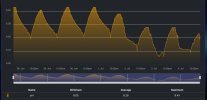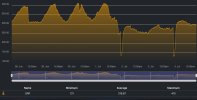Coral reefer
Past President
Seems fine
I was not planning to show my messy sump area in public, but I am curious about views on how much a skimmer should pull out in a given time (given recent events on skimmer usage in general).
This picture is a screenshot taken today from my surveillance camera in the sump. I cleaned and emptied the skimmer cup on June 15, a day before we left for our 14-day vacation, and this is what was pulled out after 12 days.
For those who know this skimmer, the pump speed is set to level 4, and the water level is set at 2.
Feeding during my absence is four times dry food through an autofeeder, and every two days one sheet of seaweed and a portion of frozen food.
Does this look like ok? I recognize it is all about stocking and feeding etc just trying to gauge ball park if this skimmer is potentially not set up well.
View attachment 57852
You call that a messy sump area? Ha! looks very nice to me.
My skimmer pulls that much gunk in about 1 day, and my skimmer cup is also much larger I think. But I feed 10+ times a day (6 auto feeders, 1 nori, 3+ shots of frozen).
You can tune it to skim dryer or wetter, as you probably know. I turn mine down to skim much drier if I'm going to be away for a few days.
. Wow, your fish are really in food heaven, but you probably do this to keep some of these sharks you have in check.
Still, this is a good benchmark, thank you for sharing. The 220 is quite a bit larger compared to the 200, and extrapolating your setup to mine, it still feels mine should pull out more. But you run much higher nitrates and phosphates from what I remember, and have much more fish, so maybe it is ok.
Fish poop is good food for downstream critters!Yes, all accurate pointsI think your skimmate is probably just fine. Is it smelly?
I do feed heavy largely to keep the sharks happy and healthy, but I also think fish poop (ammonia, trace elements, bacteria) is good for coral.
Lots of fish + lots of food = lots of fish poop. Fish poop gets a bad rap...but I think it's the secret sauce.



Happy they went to a much bigger home and will be in good hands. They love lots of frozen mysis, I was feeding PE Mysis specifically. Leaving the lights off today and add a large mirror to distract the Yellow Tang will help as well.Big fish purchase yesterday from @SupraSaltyReefer.
There are no pictures yet, as they are all in hiding (hopefully). It appears that the Zebrasoma flavescens took over the role of the tank bully from the Ctenochaetus flavicauda, who pretty much leaves everyone alone now.
- Pair of small Odontanthias borbonius
- One small Centropyge loriculus
- One small Genicanthus bellus
Hopefully, no casualties in the process of these additions.
Ohhhh no! So sorry to hear Alex.Unfortunately, I have just found the Flame Angel dead under a rock, and I very much suspect that the Bellus is dead too, although I could not find him yet.
Lessons learned are not super clear to me:
I introduced them all at once, and used a large mirror but not the entire time. Maybe I should be adding a mirror from the get go and leave it for a few days? Also turning off the lights for the first 24 hours would probably be a good idea, although the tank gets a ton of natural daylight, so not sure if it will make a big difference? We did feed immediately and extensively after adding the fish. Maybe the fish were too small, or the Yellow Tang too aggressive.
I only hope both of the Anthias will survive…
Fully agree. The fish were all super happy in your tank, which makes this even more unfortunate. I love all of these fish and would like to get them in eventually, so trying to find a different way to go past the aggression. I always thought the Whitetail was the main aggressor which no longer holds true.Ohhhh no! So sorry to hear Alex.They were happy and eating in my tank. Maybe the yellow tang was too aggressive? I feel bad tho. I’ll DM you so we can work something out.
I'm nowhere close to many others here in exp or knowledge but I think you have a very tight range with the tests even counting 6 day shipping various temperatures the samples were exposed to along the route. Its probablyReliability of home testing.
There has been a lot of talk about not chasing numbers and focusing on trends when testing. Still, I do like it if two tests have matching results. While I am not testing one home test against another, every time I get an ICP test back, I like to see how it compares to my own testing.
I have been doing monthly ICP for several months now which this tank, and the past five tests have shown very similar results to several of my home tests, which makes me believe that these tests are not as bad as I have often heard. It also makes me think that it is more the diligence of following the testing procedure that determines the accuracy than the quality of the test kit itself. Yet, some are probably more accurate than others, which I am trying to show here.
I am showing the ICP vs. home testing results below, including the test kit used:
The test has been in transit for six days, and I recognize that this might have impacted some of the test results.
- Salinity - Milwaukee - 34.7 PSU vs. 35 PSU
- Magnesium - Salifert - 1433 mg/l vs 1395 mg/l
- Calcium - Salifert - 375 mg/l vs 380 m/l
- Alkalinity - Hanna - 8.5 vs 8.6 dkh
- Nitrate - Hanna - 27.8 mg/l vs 26 mg/l
- Phosphate - Hanna - 0.118 mg/l vs 0.1 mg/l

